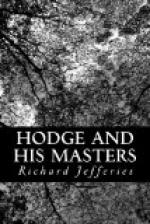Squire Filbard and one of his sons were walking round the outlying copses that October day with the object of driving the pheasants in towards the great Filbard wood, rather than of making a bag. The birds were inclined to wander about, and the squire thought a little judicious shooting round the outskirts would do good, and at the same time give his son some sport without disturbing the head of game he kept up in the wood itself. The squire was large made, tall, and well proportioned, and with a bearded, manly countenance. His neck was, perhaps, a little thick and apoplectic-looking, but burnt to a healthy brick-dust colour by exposure to the sun. The passing years had drawn some crows’-feet round the eyes, but his step was firm, his back straight, and he walked his ancestral acres every inch the master. The defect of his features was the thinness of the lips, and a want of character in a nose which did not accord with a good forehead. His hands, too, were very large and puffy; his finger-nails (scrupulously clean) were correspondingly large, and cut to a sharp point, that seemed to project beyond the tip of the finger, and gave it a scratchy appearance.
The chimneys of Filbard Hall showed for some distance above the trees of the park, for the house stood on high ground. It was of red brick, somewhat square in style, and had little of the true Elizabethan character—it was doubtless later in date, though not modern. The chimneys, however, had a pleasing appearance over the trees; they were in stacks, and rather larger, or broader apparently at the top than where they rose from the roof. Such chimneys are not often seen on recent buildings. A chimney seems a simple matter, and yet the aspect of a house from a distance much depends upon its outline. The mansion was of large size, and stood in an extensive park, through which carriage drives swept up to the front from different lodge gates. Each of the drives passed under avenues of trees—the park seemed to stretch on either hand without enclosure or boundary—and the approach was not without a certain stateliness. Within the apartments were commodious, and from several there were really beautiful views. Some ancient furniture, handed down generation after generation, gave a character to the rooms; the oak staircase was much admired, and so was the wainscoating of one part.




